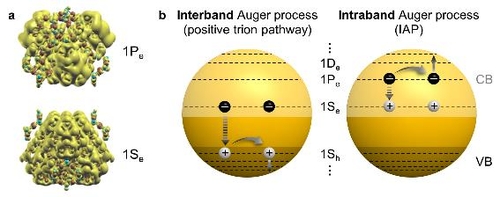IBS “First observation in units of 1,000 trillionths of electron and hole coupling in the conduction band”

[IBS 제공. 재판매 및 DB 금지]
The Institute of Basic Science (IBS) announced on the 3rd that the research team, head of the Molecular Spectroscopy and Dynamics Research Center, Min-Heng Cho (Professor of the Department of Chemistry, Korea University) has discovered a new cause of degrading the performance of quantum dot semiconductors using time-resolved spectroscopy.
Quantum dots are semiconductor particles of several nanometers (nm·1 billionth of a meter).
Due to its high efficiency and high photon emission rate, it is used in various fields such as solar cells, semiconductors, and displays.
The core of quantum dot technology depends on the path through which electrons excited by external energy (light) recombine with holes (the void where electrons disappeared).
The’ohje phenomenon’, in which excited electrons quickly combine with holes without emitting light, is a major cause of lowering the luminous efficiency of quantum dots, and is considered a task to be solved for quantum dot applications.
Although many spectroscopy studies are being conducted to determine the motion of the excited electrons, the process of changing the energy level of the electrons was complicated, making it difficult to observe.
The research team uses the’femtosecond time-resolved spectroscopy’ that can analyze samples in femtoseconds (one thousand trillionths of a second), and observes the complex electron transfer process taking place in the’conduction band’ of the quantum dot in real time. Was successful.
As a result of observation, a phenomenon in which electrons and holes recombine within about 1 picosecond (1 trillionth of a second) was found, and this was called the’Intraband Auger Process’.
The existing Oje phenomenon is a phenomenon that occurs in the’validity band’ area filled with electrons, and this is the first time that the electron-hole coupling process in the conduction band area has been revealed.
“As a result of selectively observing only electron transitions within the conduction band, we found another factor that degrades the performance of the quantum dot technology,” said Director Cho Min-haeng. “It will contribute to improving the efficiency of semiconductor quantum materials.”

[IBS 제공. 재판매 및 DB 금지]
The results of this study were published in the online edition of the international journal’Matter’ on the 30th of last month.
yunhap news
